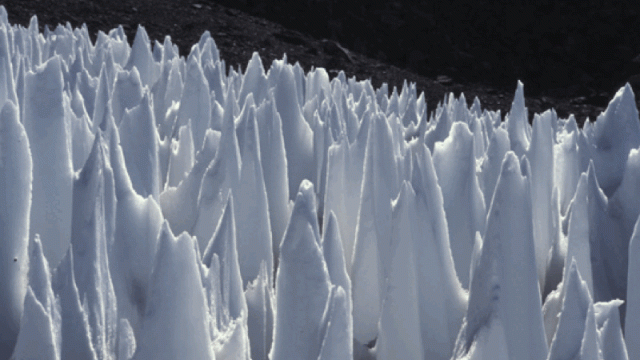Penitentes are nature’s ice sculptures: snowy pillars that form high in the Andean glaciers, where the air is particularly dry. Now physicists have figured out not only how these pillars form, but also why they tend to form at preferred spacings between columns.
They’re called “penitentes” (or nieves penitentes, Spanish for “penitent-shaped snows”) because they look eerily like a procession of white-robed monks with heads bowed in penance — specifically, those belonging to a Spanish order with habits known for tall, narrow white hats with a pointed tip. When Charles Darwin travelled from Santiago, Chile, Mendoza, Argentina in 1835, he found himself passing through snowy fields dotted with penitentes, and was so struck by the unusual formations — not to mention an unfortunate frozen dead horse — that he wrote about them in his journals:
“Bold conical hills of red granite rose on each hand; in the valleys there were several broad fields of perpetual snow. These frozen masses, during the process of thawing, had in some parts been converted into pinnacles or columns, which, as they were high and close together, made it difficult for the cargo mules to pass. On one of these columns of ice, a frozen horse was sticking as on a pedestal, but with its hind legs straight up in the air. The animal, I suppose, must have fallen with its head downward into a hole, when the snow was continuous, and afterwards the surrounding parts must have been removed by the thaw.”
The locals used to think the columns were the result of strong winds. But Meredith Betterton, a physicist at the University of Colorado, Boulder, proposed a different explanation for how they might form back in 2001. Five years later, she also created the first artificial versions of these spiky formations in the lab.

The key is a process known as sublimation. Penitentes develop when the sun’s rays evaporate snow, except the ice shifts directly into a vapour phase, without melting into water first. But some areas sublimate faster than others.
Betterton showed that even if a snowy surface starts out fairly smooth and uniform, there are still tiny crests and troughs. Sunlight gets trapped inside the troughs, bouncing back and forth off the reflective walls. That extra heat carves out even deeper troughs. The resulting curved surface concentrates sunlight like a lens, speeding up the sublimation process even more. Eventually you get an eerie forest of icy spikes.
A group of French researchers weren’t entirely satisfied with this explanation, however, noting that Betterton’s model is incomplete because it doesn’t provide an additional mechanism to explain the peculiar fixed spacing of penitentes. There should be a wide range of values in the spacing between each pillar — a “scale-free” distribution — but since there isn’t, there must be some kind of other process going on that gives rise to that preference, according to Philippe Claudin, lead author of a new paper in Physical Review E.
Claudin and his colleagues at the Institute of Industrial Physics and Chemistry in Paris (ESPCI ParisTech) have worked out their own more complex model, and found that growth of penitentes isn’t the result of sublimation from direct sunlight. Rather, they are caused by a combination of vapour diffusion and heat transport. As Philip Ball explains at Physics Focus:
“…snow is only sublimated once the light is absorbed and converted to heat. This seems obvious, but it means that the interior of the snow, where light is finally absorbed, is warmer than the surface layers. So there is a temperature gradient, the thickness and steepness of which depend on how readily light can penetrate into the snow. Secondly, if the air at the surface is saturated with water vapour, no more can escape from the solid phase, so the sublimation rate depends on the speed with which water vapour diffuses away from the surface.
“… [T]he temperature gradient adds a further mechanism — beyond the differences in irradiation described by Betterton and colleagues — for why troughs deepen in the first place. Heat is radiated less efficiently from the troughs than from the peaks, which leads to a steeper temperature gradient in the snow within the troughs. This steeper temperature gradient turns out to produce a higher sublimation rate, so that the troughs become self-amplifying in the early stages of growth.”
Adding these variables accounts for the periodic spacing. How far apart the penitentes form depends on the rate at which the vapour diffuses; the faster it does so, the further apart the columns will be.
The complex physics behind their formation is even more reason to marvel at nature’s exquisite artistry in sculpting these rare icy pillars.
Images: (top) Field of penitentes in the Central Andes, Argentina. Credit: User: Arkavi, via Wikimedia Commons. (bottom) Micropenitentes in the lab. Credit: Paul Dubuc/Physical Review Letters (2006).
References:
Bergeron, Vance; Berger, Charles; and Betterton, M.D. (2006) “Controlled irradiative formation of penitentes,” Physical Review Letters 96: 098502.
Betterton, M.D. (2001) “Theory of structure formation in snowfields motivated by penitentes, sun cups, and dirt cones,” Physical Review E 63: 056129.
Claudin, Philippe, et al. (2015) “Physical processes causing the formation of penitentes,” Physical Review E 92: 033015.
Darwin, Charles. Journal of researches into the geology and natural history of the various countries visited by H.M.S. Beagle, under the command of Captain Fitz Roy, R.N., 1832 to 1836. London: H. Colburn, 1839.
Lliboutry, L. (1954b) “The origin of penitentes,” Journal of Glaciology 2: 331-338.
